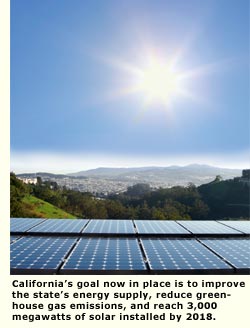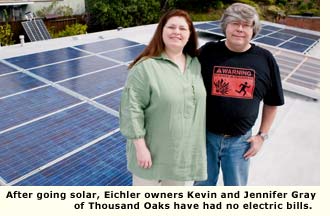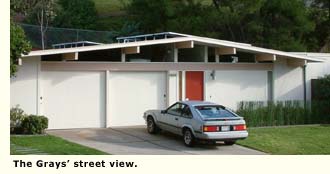Energy: Sun Power Rising
 While some homeowners stuff their hard-earned dollars under mattresses in an uncertain economy, others hang them outside for all to see—on rooftop solar panels. "Where else can you invest in something that's not going away?" asks Randy Feriante, owner of Dura-Foam Solar Center, a Menlo Park-based solar-electric dealer. "Everybody needs electricity."
While some homeowners stuff their hard-earned dollars under mattresses in an uncertain economy, others hang them outside for all to see—on rooftop solar panels. "Where else can you invest in something that's not going away?" asks Randy Feriante, owner of Dura-Foam Solar Center, a Menlo Park-based solar-electric dealer. "Everybody needs electricity."
California is the nation's leader in rooftop solar, with well over half the country's installed capacity. There's good reason why: California's electricity rates have historically increased by 6.7 percent per year, and prices continue to rise.
That's why the state launched the California Solar Initiative in 2007, in an effort to drive solar-electric systems (also known as photovoltaic or PV systems) on a mass scale. The goal is to improve the state's energy supply, reduce greenhouse gas emissions, and reach 3,000 megawatts installed by 2018.
Funded by utility customers across the state, the $3 billion program offers rebates to Californians who install solar panels on their homes and businesses. Refunds typically range from 20 to 50 percent of a system's cost.
Solar power can dramatically reduce a homeowner's electric bill, but the savings comes at a big upfront cost. It currently takes about nine to 10 years for the cost of a solar installation to pay for itself.
There are several upshots, however. If one uses a grid-tied system, any excess power their solar system generates during the day can be sold back to the utility company.

Of course, solar is good for the environment, too. The utility companies get most of their present power from burning fossil fuels, which pollute the air and are responsible for the bulk of greenhouse emissions. Solar energy, in comparison, is clean and non-polluting. Over the next 15 years, a solar system for a typical three-bedroom home will offset 82,000 pounds of carbon dioxide (CO2), according to SolarCity, a solar installer with dealerships throughout California.
"There's no downside to having solar," Dura-Foam's Feriante says. "You are always going to need electricity. If you put it on your roof, your property is worth more, and every month it is paying you back."
"Many of our present customers are expressing an interest in sizing their solar systems to power electric cars for the near future," adds Feriante. "The numbers indicate, and engineers are found to agree, that two kilowatts would be enough to provide the power for 40 miles a day for the electric Chevy Volt. The electrical give and take with the grid makes this possible and convenient."
While capturing sunlight and converting it into electricity, photovoltaic systems can be either on-grid or off-grid, meaning they are connected to the region's electrical power grid or are stand-alone systems that supply only the individual home. On-grid PV systems draw power from the local utility company as needed and feed excess energy that's generated but not used back to the utility company.

Federal law requires the local utility to buy PV-generated electricity from homeowners, based on net energy metering agreements. Under net metering, the electric meter runs backward as a customer's solar system generates surplus electricity. The utility company generates a bill credit for the full retail value of the electricity the PV system is producing. The methods of applying credit for exported energy vary from program to program.
"The net metering agreements work almost like rollover minutes from a mobile phone," says SolarCity CEO Lyndon Rive. "In the summer you will likely produce more power than you need, and in the winter you will use more power than you produce." Any credits garnered from the utility company can be used towards paying electric bills for the months homeowners use more electricity than they produce.
Homeowners who want to take advantage of California Solar Initiative incentives have to install an on-grid PV system and be customers of Pacific Gas and Electric (PG&E), City of Palo Alto Utilities, Southern California Edison (SCE), or the Sacramento Municipal Utility District.




